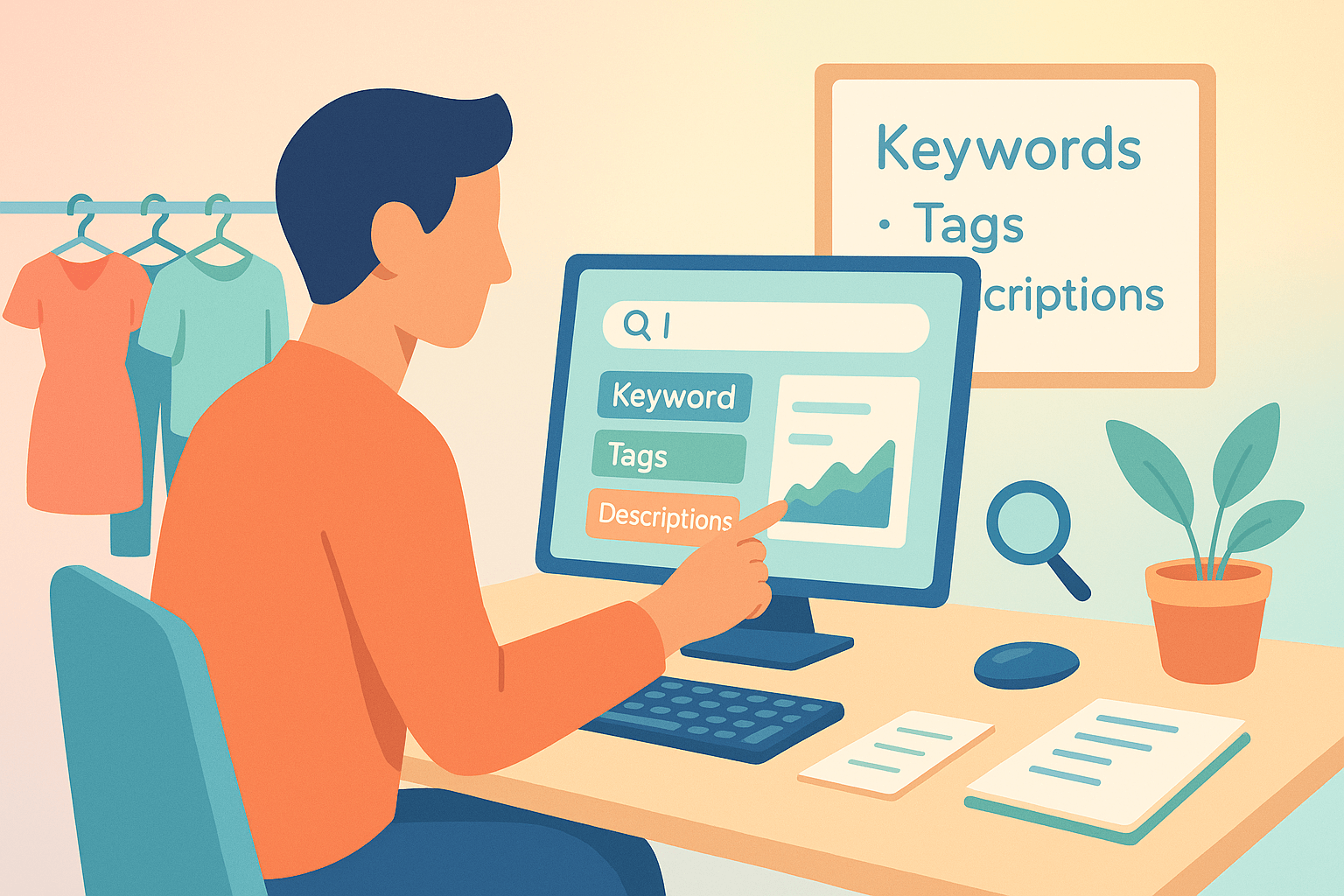How to sell on multiple marketplaces: The complete guide
.png)
Sell on multiple marketplaces by using a crosslisting tool to save time and keep your inventory organized.
Multi-market selling can increase your listings’ visibility and provide diverse revenue streams. For instance, a vintage jacket might sell for $45 on Poshmark's fashion-focused audience, but trend-conscious Gen Z buyers could pay over $75 on Depop.
However, multi-marketplace selling creates challenges, like managing and tracking inventory across platforms. We’ll discuss selling successfully on multiple marketplaces while avoiding costly mistakes, and we’ll introduce Nifty as a tool that eliminates manual busywork so you can scale smarter.
How to sell on multiple marketplaces successfully
Sell on multiple marketplaces successfully with strategic planning, proper tools, and systematic processes. Sell with these multi-marketplace strategies to help increase your bottom line as a reseller:
Step 1: Standardize your listings
Maintain consistent listing title formats across all platforms. This improves your search visibility and keeps you organized. For instance, always list the same title for a particular handmade coffee mug, “Handmade glazed coffee mug,” across eBay, Mercari, and Etsy to avoid confusion.
A crosslisting tool like Nifty can execute these tasks for you. It can generate your listing information from a picture or, if you already have it, upload that information to your account. Nifty automatically fills in item details across connected marketplaces.
Pro tip: Write professional-sounding descriptions that highlight key features, measurements, and condition details. This information answers buyer questions immediately. Always use high-quality, consistent images across all platforms. A photo-editing tool like Photoroom (accessible via Nifty) can help.
Step 2: Set centralized pricing and inventory rules
Get a crosslisting tool that lets you schedule pricing updates consistently across platforms and takes each platform’s fees into account. Consistent pricing helps maintain competitiveness without the need for manual monitoring of competitor prices across multiple marketplaces.
You should also consider a crosslisting tool that offers auto-delisting across all platforms to prevent double-selling. For instance, when a crosslisted item sells on eBay, quality crosslisting software will automatically remove that duplicate listing from Etsy and Depop, saving time and avoiding headaches.
Step 3: Create a consistent fulfillment workflow
Smart sellers know each platform’s shipping policies to deliver on time and avoid penalties or cancellations. Use standardized packaging materials to maintain a professional presentation. Follow a set process to prevent errors and ship promptly, regardless of the marketplace.
Why do sellers use multiple marketplaces?
Sellers use multiple marketplaces to reach more customers and increase their revenue potential. By selling the same items on different marketplaces (crosslisting), you appeal to different buyer demographics. Here’s a breakdown of why sellers crosslist:
- Reaches more buyers: Multi-marketplace selling connects your inventory to millions of additional shoppers who prefer specific platforms for their unique features and communities. Items that sit unsold on one platform can find eager buyers on another.
- Reduces risks: Spreading sales across multiple platforms protects your business from sudden policy changes, account suspensions, or algorithm updates that can devastate single-platform sellers overnight.
- Better inventory turnover: Cross-platform listing can help your products reach ideal buyers faster, preventing items from becoming stale inventory that requires markdowns or storage costs.
- Pricing optimization can help profit margins: Different marketplaces support varying price points for identical items based on their unique buyer demographics and shopping cultures. Strategic pricing across platforms allows you to capture maximum value from each sale by matching your items to the marketplace where buyers pay premium prices.
Popular platforms for multi-channel selling
How to choose the right marketplaces for your products
Choose the right marketplaces by analyzing your target audience, product categories, and similarly priced items on various platforms. Use this list to guide you toward making the right decision to list your items:
Major general marketplaces
General marketplaces attract diverse buyer demographics and support virtually any product category. This makes them a suitable place to list nearly any product. These platforms provide the largest customer bases, though competition remains fierce across all categories.
- eBay: A trusted marketplace since the late 1990s, eBay's auction and fixed-price formats accommodate everything from rare collectibles to household items. It supports international shipping, connecting you to buyers worldwide. The platform offers tools like advanced analytics and promotional features, but they only work on eBay.
- Amazon: With an enormous global customer base and Prime membership program, Amazon creates unparalleled buying intent. The platform's fulfillment services and advertising tools can help you scale quickly, though strict quality standards and intense competition require consistent inventory management.
- Facebook Marketplace: Part of the enormous Facebook ecosystem, Facebook Marketplace blends social media and selling. It facilitates local transactions without shipping complications, making it perfect for bulky items and immediate cash sales to buyers in your area.
Fashion & apparel platforms
Fashion-specific marketplaces are communities of shoppers who actively seek trendy, branded, and unique clothing items at various price points. These users understand fashion resale dynamics and provide specialized tools for showcasing apparel effectively.
- Poshmark: With social features like sharing, following, liking, and live-stream promotional events, Poshmark creates communities where sellers build personal brands and loyal customer bases. The platform's flat-rate shipping and authentication services keep its fashion-focused audience consistently engaged.
- Depop: This platform offers an Instagram-style interface that appeals to younger buyers seeking unique, vintage, and alternative fashion pieces. Depop’s global reach and trend-focused community make it ideal for sellers offering Y2K fashion, streetwear, and one-of-a-kind pieces that command higher prices from aesthetic-conscious shoppers.
- Vinted: Vinted's commission-free model for sellers and buyer protection fees creates an attractive environment for moving mid-range fashion items quickly at competitive prices. The platform's mobile-first approach attracts budget-conscious fashion shoppers seeking quality secondhand clothing without premium marketplace fees.
Handmade & vintage marketplaces
Specialized platforms for handmade and vintage goods attract buyers specifically seeking unique, authentic, or artisanal products that mass retailers cannot provide. These marketplaces support sellers who create or curate special items with dedicated audiences willing to pay premium prices for quality and uniqueness.
- Etsy: This global marketplace connects creative sellers with buyers seeking handmade, vintage, and craft supplies. You can use SEO tools so your products gain traction on the platform, with listing features that allow you to emphasize your story as a maker to better connect with buyers.
- Ruby Lane: Ruby Lane specializes in antiques, vintage items, and collectibles with rigorous quality standards that attract serious collectors and dealers seeking authenticated pieces. The platform's curated approach and expert community create premium pricing opportunities for sellers offering genuine vintage items.
Niche and specialty platforms
Specialty marketplaces focus on specific product categories or collector communities. You’ll often find audiences willing to pay premium prices for authenticated items. These users understand their niches intimately and provide specialized tools that general marketplaces cannot match.
- Grailed: A curated marketplace focusing on high-end men's fashion, streetwear, and designer pieces, Grailed attracts knowledgeable buyers willing to pay premium prices. Its authentication services and detailed condition grading system build buyer confidence, while its fashion-forward community creates strong demand for rare and limited-edition pieces.
- StockX: With a stock market approach to luxury goods trading, StockX creates competitive bidding environments that result in premium prices for authenticated sneakers, streetwear, and collectibles. The platform features rigorous authentication processes and real-time market data to attract serious collectors and investors.
- GOAT: Sneaker and footwear enthusiasts flock to GOAT because it combines new releases with authenticated resale inventory. GOAT offers a condition grading system and consignment options to provide flexibility for sellers while maintaining buyer confidence through professional authentication and quality assurance programs.
The biggest challenges of multi-channel selling
When you crosslist without proper planning or tools, you’ll face major operational challenges that can slow your selling. Without software to manage inventory and pricing, crosslisting becomes tedious and error-prone.
The following challenges come with selling on multiple marketplaces:
1. Inventory tracking chaos
Each marketplace operates independently, so each requires updates whenever item quantities change or new inventory arrives. Managing stock levels across multiple platforms without crosslisting software creates a situation where sellers constantly risk mismanaging and double-selling, or missing sales opportunities entirely.
2. Pricing and description inconsistencies
Maintaining consistent pricing and product descriptions across multiple marketplaces becomes nearly impossible without dedicated tools to update information automatically. Different platforms have varying character limits for descriptions and titles, category structures, and formatting requirements. These standards force sellers to recreate listings repeatedly with slight variations.
Unfortunately, manual price and listing updates across platforms consume several hours, increasing the margin for costly errors.
3. Order management and shipping problems
Processing orders from multiple marketplaces requires juggling different shipping requirements, label formats, tracking systems, and delivery expectations for each platform. Without multichannel listing software, you’ll need to remember these different rules.
If you miss platform-specific shipping details, you could encounter delayed deliveries, negative feedback, and potential account penalties. The complexity multiplies exponentially with order volume, turning what should be profitable sales into logistical mistakes that overwhelm small business operations.
4. Platform-specific rules and algorithms
Each marketplace enforces unique policies regarding product categories, listing formats, keyword usage, and behavior that you must understand to avoid violations. For instance, sharing listings too often on Poshmark can negatively affect your closet’s visibility.
Staying compliant across multiple platforms means monitoring policy updates, adjusting listings accordingly, and understanding each marketplace’s nuanced rules.
What do crosslisting tools do?
Crosslisting tools simplify organizing your inventory across multiple marketplaces. Instead of jumping between tabs and playing copy-and-paste hopscotch, crosslisting tools provide a central location where you can upload, manage, and edit all your listings and then post them to each marketplace. Here are some ways crosslisting tools help resellers:
- Multi-channel distribution: Crosslisting tools instantly distribute your product listings to multiple marketplaces simultaneously, transforming single-platform inventory into multi-channel opportunities.
- Delist sold items: By detecting sales across all connected platforms, crosslisting tools immediately remove listings from other marketplaces to prevent double-selling.
- Manage inventory from one place: Unified controls combine inventory management, order processing, and performance tracking across all connected marketplaces into a single interface.
- Performance analytics and insights: Crosslisting tools consolidate revenue data, costs, and overall performance into an analytics dashboard to reveal which platforms and products generate the highest returns.
Not every crosslisting tool offers these features. Some only support 2 or 3 platforms, leaving many tasks manual. Always research each tool and use a free trial before purchasing.
5 crosslisting tools for selling on multiple marketplaces
Why does Nifty stand out?
Nifty differentiates itself from competitors by offering advanced AI automation and generation features that eliminate manual tasks. It also has pricing plans for serious, high-volume sellers and beginners starting to build their inventory. Here’s why Nifty is a popular choice for crosslisting:
- One-click multi-platform distribution works: Nifty's unified upload system distributes your product listings to your Poshmark, eBay, Mercari, Depop, and Etsy stores. More marketplaces coming soon!
- Schedule automated relisting: Use Nifty’s scheduling feature to relist aging inventory, which Nifty automatically identifies and recreates listings to refresh search visibility across connected platforms.
- Platform analytics reveal profitable channels: The tool’s analytics dashboards show which marketplaces generate the highest profits, fastest sales, and best conversion rates for specific product categories.
- Single interface eliminates platform chaos: Nifty consolidates all marketplace management tasks into one clean interface, eliminating the need to juggle multiple browser tabs and platform-specific controls.
Scaling a multi-marketplace business: What to know
Scaling a multi-marketplace business requires strategic automation and building your own system to manage increasing inventory. If you’re managing 500+ listings across 5 platforms, you’ll need a crosslisting tool, a process for using it, and a plan to expand to more platforms.
Add new marketplaces only after achieving consistent profitability and steady productivity on your existing platforms. Monitor key metrics like monthly recurring revenue, profit margins, and time spent on daily operations to determine when your current setup can support additional complexity.
Successful expansion requires at least 3 to 6 months of stable operations where you're meeting sales targets without an overwhelming workload. The ideal time to expand is when you have excess inventory capacity, proven systems for managing current platforms, and clear data showing demand for your products in new market segments.
Simplify multi-platform selling with Nifty
Now that you know how to sell on multiple marketplaces and understand the benefits, consider using a crosslisting tool to simplify the process. We recommend giving Nifty a shot, as it offers crosslisting to multiple platforms and AI features. Here’s what you get with Nifty:
- Generate listings from photos: Upload an image, and Nifty’s AI generates a full listing with optimized titles, detailed descriptions, and relevant hashtags.
- Crosslist across five marketplaces: Instantly post to Poshmark, eBay, Mercari, Depop, and Etsy (more on the way!), while updating inventory to avoid duplicate sales.
- Automate repetitive tasks: Relist, schedule sharing on Poshmark, and adjust prices in bulk without manual work.
- Monitor performance easily: Track sales, fees, top sellers, and slow movers in one clear command center.
- Create professional product photos: Use Photoroom for background removal, cropping, and image adjustments.
Try Nifty with a 7-day free trial and see how it can save time, increase your inventory’s visibility, and bring in more revenue.
FAQs
1. Is it worth selling on multiple marketplaces?
Yes, selling on multiple marketplaces is worth it because you can expand your buyer reach, reduce platform dependency risks, and optimize pricing across different demographics. Multi-marketplace selling can also increase revenue by connecting identical products to diverse audiences willing to pay varying price points.
2. How do I keep inventory updated across platforms?
You keep inventory updated across platforms by using crosslisting tools that automatically detect sales and update quantities in real-time across all connected marketplaces. Tools like Nifty delist sold items from other platforms when sales occur, preventing double-selling and eliminating the need for manual inventory tracking across multiple marketplace accounts.
3. Can I post the same item on multiple sites?
Yes, you can post the same item on multiple sites by using a crosslisting tool, which is a common practice among resellers seeking maximum exposure. Most crosslisting platforms format your listings to meet each marketplace's requirements across platforms like eBay, Poshmark, Mercari, Depop, and Etsy simultaneously.





